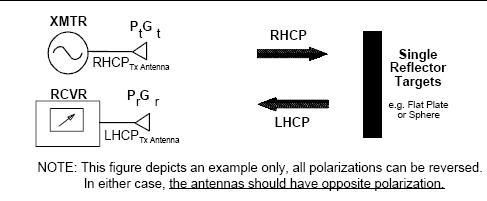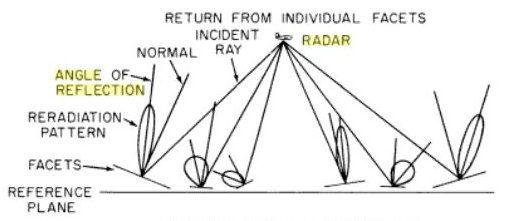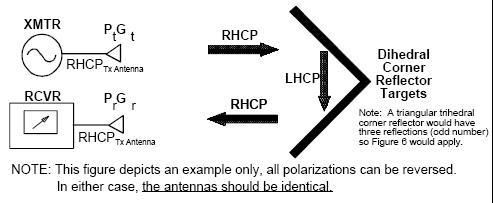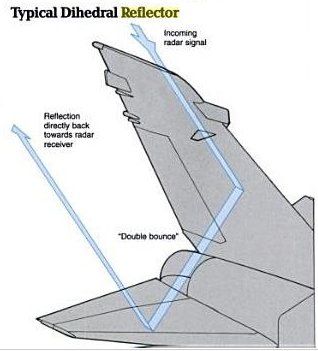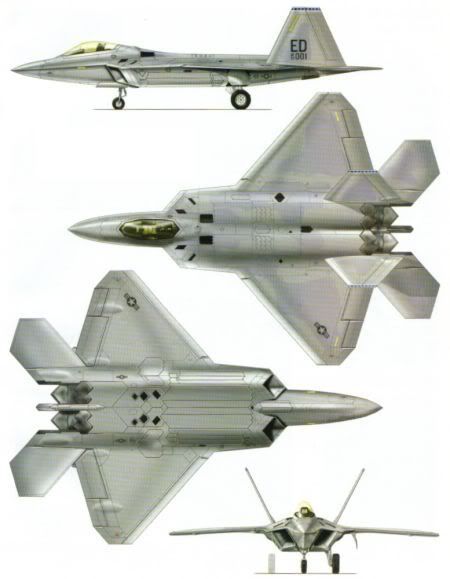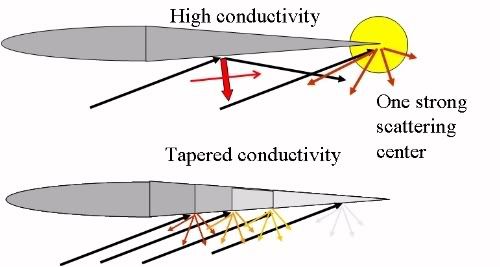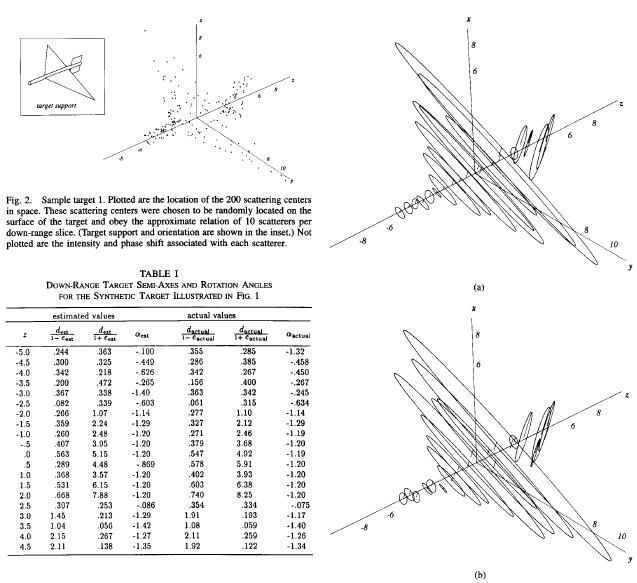Do u Know wat was the BIGGEST advantage of the takedown......?
Ans-The Wreckage was sent to RUSSIA ......Tat says it all
What it says is that you do not know what you are talking about and can only put on airs. In order to show you why you and the rest of the gang is wrong, there must be some education on basic radar behavior. So here goes...
In the image above, if an EM wave, or signal, or pulse, whatever you want to call it, impact a
PLANAR surface that is directly facing the radar, the echo will be strongest.
However, if the surface is angled slightly, no matter how much, then the echo will deflect away from source direction.
So in theory, if the surface is not directly facing the radar and is also perfectly smooth, then the radar will not detect that surface.
What is illustrated above is called a 'target corner reflector' where two surfaces or two edges meet and form a 90 deg corner. This is not good if the goal is to reduce radar cross section (RCS). Corner reflectors exists all over an aircraft such as where the external stores pylon is connected to the underside of the wings.
The above examples are how a 'non-stealth' aircraft create a corner reflector with its own flight control surfaces. Look at the B-1's head-on view. Not just the flight control surfaces but see how its engine intake construction create corner reflectors with the body?
Deluxe Echomaster Radar Reflector from DAVIS INSTRUMENTS
These 12 1/2" dia. reflectors are very common on many cruising boats. All models can be stored flat and assemble in minutes. Plates are held together by tough, injection molded corner latches. Assembled reflectors include a 1 1/4" (32mm) windage hole for reduced aerodynamic drag, which also allows for backstay mounting. Standard Echomaster: 13.2 square yards (12 square meters) of radar cross section in the 9-9.6 GHz X or 3cm radar band. Plates are made of 1.3mm non-anodized marine grade aluminum. Assemble around a backstay or make your own bridle and hang from holes that are drilled in the corner latches. Deluxe Hanging Echomaster: Includes a hanging mount harness for suspending the unit from the mast or rigging in a "catch rain" orientation. Includes vinyl storage case. Economy Radar Reflector: A great backup aboard larger boats or primary reflector on smaller vessels that might not normally carry a radar reflector. Made of foam core plastic-metal foil laminate. Economical enough for any boat. Performs nearly as well as Echomaster, and stows flat. 11.5" (29cm) dia.
As we can see, corner reflectors are good for coastal marine safety reasons. But notice the figures...A target corner reflector with only 12 inches in diameter become 13 square yards on the radar scope...!!! So imagine how large an aircraft can be when its flight control surfaces just happened to create such a device. Also note the freq as the X-band, or centimetric, is also used by military radars. Missile seekers are also X-band.
Small boats
WANTED to be detected, else they get run over by larger vessels. Any vessel, waterborne or airborne, that
WANTED to be seen is called a 'cooperative' target. But hostile aircrafts do not want to be detected, so any vessel, waterborne or airborne, that do
NOT wanted to be detected is called a 'non-cooperative' target. Electronic countermeasure (ECM) pod or flying at very low altitude to electronically hide in ground clutter make an aircraft a non-cooperative target.
No surface is perfectly smooth. Microscopic irregularities create visible and non-visible corner reflectors. Some of the echo will reflect back to transmitter direction, some will reflect away. But ultimately, with these microscopic and large surface area corner reflectors, they are how radars detect aircrafts.
So we have the SR-71, F-18, F-117, F-15 Silent Eagle, F-22 and F-35 with their angled vertical stabs.
The SR-71, for example...
If we look at the two vertical stabs alone and their relationships to the fuselage, we can see that the outer corner reflectors are greater than 90 deg and the inner corner reflectors are less than 90 deg, turning any reflections away from the source direction.
For the F-22, it is the reverse. The outer corner reflectors are less than 90 deg and the inner reflectors are greater than 90. Their effects are the same for both planforms.
The greatest echo power will be when the radar is either directly from the top or bottom view of the aircraft and this situation is an extremely rare occurrence as aircrafts usually move.
Petr Ufimtsev - Wikipedia, the free encyclopedia
Petr Yakovlevich Ufimtsev (Russian: Пётр Я́ковлевич Уфи́мцев) (born 1931 in Altai Krai) is a Russian physicist and mathematician, considered the seminal force behind modern stealth aircraft technology. In the 1960s he began developing equations for predicting the reflection of electromagnetic waves from simple two-dimensional shapes.
Much of Ufimtsev's work was translated into English, and in the 1970s American Lockheed engineers began to expand upon some of his theories to create the concept of aircraft with reduced radar signatures.[1] Northrop made extensive use of Ufimtsev's work in developing the B-2 bomber. Professor Ufimtsev currently teaches at the University of California, Irvine (UCI).
Note the highlighted. Ufimtsev did not create 'stealth', rather he created the equations that predict the behavior of a signal. If you can predict the behavior of something, you can create the necessary conditions that will affect the behavior or even produce the behavior that you want. Lockheed and even the Nazis knew about these behaviors but none managed to come up with the math to
PREDICT how an EM pulse would behave. There were no aerodynamics advantages to the angled vertical stabs on the SR-71. Lockheed just knew they had to do something about them being corner reflectors. But once Lockheed got a hold of Ufimtsev's equations, they created the F-117 with its many angled facets.
But just because the undersides of the B-2, F-117, F-22 and F-35 are visibly flat, it is deceiving because of other behaviors of an EM wave on a surface...
With 'tapered conductivity', instead of one large echo, we create several smaller ones, hopefully some of them will get lost into the clutter region, reducing the total echo amount that leave the aircraft. We do not really care how many radars are out there looking. We just want to minimize that total echo power. So to create a non-cooperative target through body shaping, or planforming, we have angled facets and surfaces and finally tapered conductivity for where we cannot create facets. The earliest result of 'stealth' aircraft is the F-117.
So do you really believe that the Russians and the Chinese can do anything with that F-117 wreckage? Do you really believe that they can just slap together some facets and produce an actual flying F-117 equivalent with the same low RCS? If they could, why have they not? It would a technical coup for them as they could boast that not only can their radars detect, track and target US 'stealth' aircrafts but also they could recreate our junks at their leisure. Countries would be waving wads of cash and bonds to buy their weapons. NATO members would question US technological lead.
An aircraft is a complex body. It is not uniform. Do not mistake symmetry for uniformity. Your face is (hopefully) symmetrical but it is not uniform. On each side of your face, there is only one eye, one ear and half of mouth and nose. Nowhere else do these items appear.
The above is how an aircraft, a complex body, create radar scattering, or reflection, points and how that complex body is electronically seen
BEFORE those scattering points are calculated and
PERCEIVED to be a valid target.
The most important item about radar detection is that it is a statistical process. The fancy word is
STOCHASTICAL. It mean those scattering, or reflection, points
MUST appear consistently over time and that they
MUST be in a cluster. An 'ambiguous' target is where the radar computer receive less than statistically optimal scattering points and warns the operator of that uncertainty. At this time, it will be up to the human operator to determine if it is worthwhile to pursue this ghost or to ignore it. A low amount of scattering points equals to a high degree of uncertainty. The goal of 'stealth' is to create that high level of uncertainty and maintain it for the enemy for as long as possible. We have never claimed 'stealth' to be 'invisible' to radar. By the time-distance combination that the 'stealth' aircraft is close enough for those scattering points to be strong enough for the radar to declare a target exist, it would have been weapons release for the 'stealth' aircraft, in other words, it would have released its bombs or missiles and is on its exit.
Because an aircraft, 'stealth' or not, is a complex body, its RCS value will also be non-uniform. That is why the head-on perspective has the lowest RCS value compared to other views of that same aircraft. This applies to the giant C-5 or B-52 as well. Their head-on views will be smaller than their sides or top or bottom views. So in order to verify if the actual full scale body matches the calculations, there must be full body measurements at all angles, or views.
Edwards Air Force Base - Media Search
The Benefield RF Anechoic Facility is the largest chamber in the world, capable of measuring even the C-5 and the B-52 from all angles. BMW sent their cars to US for RF measurements. We can test ECM capability, from a full pod to a small antenna as installed on the aircraft.
So just because the Russians and the Chinese may have scraps of the unlucky F-117, that does not mean they can create their own versions of the aircraft. Testing facility like Benefield do not come cheap, in money and human intellect. Even if the Russians can recreate something similar to the F-117, without full scale RF anechoic measurements, what they create would at best be doubtful, if not outright as non-stealthy as regular aircrafts.
The F-117 and its primary method of RCS reduction, angled faceting, is out of date. The current generation exploit the 'creeping wave' behavior and I have referenced that in other responses. The 'creeping wave' behavior is how the B-2, F-22 and F-35 have more curves than angled facets and uses far less radar absorber (RAM) than the F-117.
What I presented here, limited by the forum's software to only 10 images, is only the surface of 'stealth' and only on the body shaping, or planforming, of the idea, not yet RAM, passive or active. I have not even touch on LPI AESA radar mode, an important component of the current generation of US 'stealth' aircrafts. AESA radars are being installed on older US aircrafts.
You are treading into a territory that clearly you know nothing about other than to spout one-liners to give an air of sophistication.

 ) plane!
) plane!